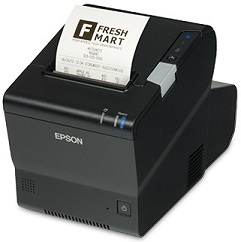Introduction
Thermal paper has become an integral part of our daily lives, particularly in the realm of business transactions and record-keeping. Whether you're dealing with thermal receipt paper at the cash register or handling important documents printed on thermal paper rolls, the issue of fading prints over time is a common concern. In this comprehensive guide, we will delve into the intricacies of thermal paper, explore the factors contributing to its deterioration, and equip you with effective techniques on how to restore thermal paper, ensuring the longevity of your valuable receipts.

Understanding Thermal Paper
A. The Basics of Thermal Paper
Before we embark on the journey of restoring thermal paper, it's crucial to grasp the fundamentals of this unique type of paper. Thermal paper is coated with a special type of dye and a developer chemical. When heat is applied, usually through a thermal printer, the dye reacts with the developer, resulting in the creation of images or text on the paper. This process eliminates the need for traditional ink, making it an efficient and widely used medium, especially in point-of-sale systems.
B. Applications of Thermal Paper
Thermal paper finds extensive use in various sectors, with one of its primary applications being in the printing of receipts. Thermal receipt paper is favored for its speed, cost-effectiveness, and ease of use in retail environments. Thermal paper rolls are also employed in other areas such as ticketing, labeling, and medical recording, showcasing its versatility in different industries.
Factors Contributing to Thermal Paper Deterioration

A. Exposure to Light
One of the main culprits behind the fading of thermal paper prints is exposure to light, particularly ultraviolet (UV) light. Over time, continuous exposure can lead to the breakdown of the dye and result in the gradual disappearance of text or images on the paper. This factor is especially relevant when dealing with thermal paper receipts that are often stored in wallets or on bulletin boards.
B. Heat and Humidity
Aside from light, heat and humidity also play significant roles in the degradation of thermal paper. Excessive heat can accelerate the reaction between the dye and developer, causing prints to fade more rapidly. Similarly, high humidity levels can lead to the deterioration of the paper itself, affecting its overall quality and legibility.
C. Contact with Chemicals
Contact with certain chemicals, such as those found in cleaning agents or plasticizers, can have adverse effects on thermal paper. The chemicals may react with the paper's coating, altering its composition and compromising the integrity of the prints. It's essential to be mindful of the surroundings where thermal paper receipts are stored to prevent unintentional exposure to harmful substances.
Techniques for Restoring Thermal Paper
A. Assessing the Extent of Damage
Before diving into restoration techniques, it's crucial to assess the extent of damage to the thermal paper. This involves examining the degree of fading, any discoloration, or physical damage to the paper itself. A thorough assessment will help determine the most appropriate method for restoration.
B. Protecting Thermal Paper from Further Damage
To prevent further deterioration, it's essential to implement protective measures. This includes storing thermal paper receipts in a cool, dark environment with controlled humidity levels. Utilizing protective sleeves or folders can also shield thermal paper from direct contact with potentially harmful substances.
C. Image Enhancement Software
In cases where the fading is not extensive, image enhancement software can be a valuable tool for restoring thermal paper prints. These programs are designed to adjust contrast, brightness, and color levels, potentially improving the legibility of faded prints. However, it's essential to note that this method may not be effective for severely damaged thermal paper.
D. Thermal Paper Restoration Sprays
The market offers various thermal paper restoration sprays designed to revive faded prints. These sprays typically contain chemicals that reactivate the thermal paper coating, restoring the appearance of the prints. When using such sprays, it's crucial to follow the manufacturer's instructions carefully to achieve optimal results without causing further damage.
E. Heat Transfer Method
The heat transfer method involves using controlled heat to reintroduce the dye into the paper, revitalizing the prints. This method requires the use of a heat source, such as a clothes iron, and a protective barrier, such as a sheet of plain paper or a cloth, to prevent direct contact between the iron and the thermal paper. Careful application of heat can bring back the vibrancy of faded prints.
F. Professional Restoration Services
For valuable or irreplaceable thermal paper documents, seeking professional restoration services may be the most prudent option. These services often employ advanced techniques and equipment to restore thermal paper to its original condition. While more expensive than DIY methods, professional restoration ensures a higher likelihood of success, especially for severely damaged thermal paper.

Best Practices for Handling Thermal Paper
A. Proper Storage
To prolong the life of thermal paper prints, proper storage is paramount. Keep receipts in a cool, dark place, away from direct sunlight and heat sources. Avoid storing thermal paper rolls in areas with high humidity, as moisture can compromise the paper's integrity.
B. Photocopying or Scanning
Consider making photocopies or scans of important thermal paper documents as a preventive measure. This creates a backup copy, ensuring that even if the original fades over time, you have a replicated version for reference.
C. Regular Inspections
Conduct regular inspections of stored thermal paper receipts to identify any signs of deterioration early on. Prompt action can be taken to prevent further damage or, if necessary, initiate restoration efforts before the prints become irreversibly faded.
Conclusion
In conclusion, understanding the intricacies of thermal paper and the factors contributing to its deterioration is crucial for preserving important documents. Whether dealing with receipt paper at a retail establishment or thermal paper rolls used for various applications, implementing proper handling and storage practices can significantly extend the life of thermal paper prints. In cases where restoration is necessary, various techniques, from image enhancement software to professional restoration services, can be employed based on the extent of damage.
By taking a proactive approach to thermal paper preservation and restoration, individuals and businesses can safeguard their valuable records and ensure that the information remains legible for years to come. As technology continues to advance, it is likely that new methods and solutions for restoring thermal paper will emerge, further enhancing our ability to preserve these important documents.






